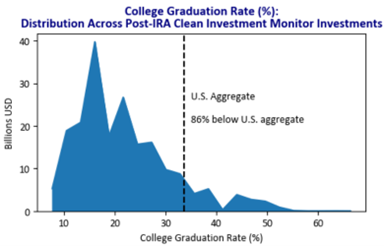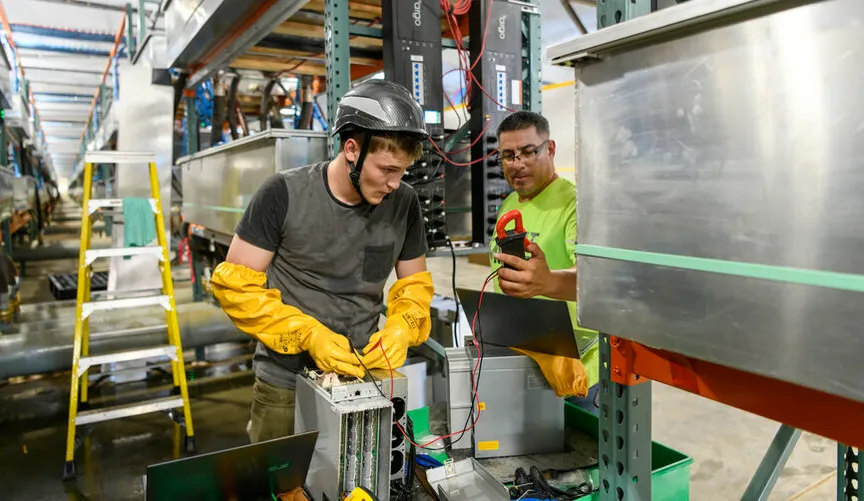Another Unlock for IRA Success: Immigration Reform?
from Slow Boring, published as:
Immigration can power American energy
A plan to unlock energy abundance and unleash economic growth
President Biden rarely talks about the Inflation Reduction Act’s massive clean energy investments without mentioning the millions of new American jobs it’s set to create over the coming decade.1
And for good reason: It’s a tidy policy vision that resonates with voters across the ideological spectrum. From the climate concerned to the totally unbothered, who’s against American job creation?
Unlocking the industrial might of the American worker is certainly a worthy proposition, but the reality might not be as clear as the administration makes it out to be. Our labor market is tighter than a rotten clam shell, companies in the clean energy sector are already struggling to hire workers, and while job training programs exist, we’re looking at a job market that, according to the Political Economy Research Institute, could grow to 9 million by the end of the decade.
In short, we won’t be able to unlock the full might of the IRA’s investment capital without the complementary labor capital to build it.
What’s the solution? Expanded skills based immigration. Specifically, specialized visas that will allow clean energy companies to hire skilled workers who can help build the infrastructure we need to unleash energy abundance.
Let’s call them Energy Visas. Because just like American jobs, who doesn’t love energy?
Energy Visas
“Job” is obviously an amorphous term. It’s worth asking, what jobs are being created in the clean energy sector, and consequently, what types of workers will be eligible for the Energy Visa program?
We might be inventing a new visa program, but we don’t need to invent any new definitions. The Department of Energy defines “clean energy jobs,” as related to “renewable energy; grid technologies and storage; traditional electricity transmission and distribution for electricity; nuclear energy; a subset of energy efficiency that does not involve fossil fuel burning equipment; biofuels; and plug-in hybrid, battery electric, and hydrogen fuel cell vehicles and components.
This encompasses a wide range of jobs. But to give you an idea of which needs the Energy Visa program will look to fill, let’s look at some of the areas that need it the most.
Nine out of ten US solar companies are struggling to hire skilled labor for new installations. There’s already an 80,000-electrician shortage, and we’ll need about a million new ones by the end of the decade. The wind turbine industry, EV battery sector, and nuclear industry are all facing and will face increasing worker needs in the coming years.
In addition to these labor shortages, Brookings economist Sanjay Patnaik told me that what’s “often unappreciated, is that the number of job separations projected are even higher, compounding the need to prepare the labor force for these jobs.” He also shared a study that showed we could be looking at a green skills gap of 7 million by the end of the decade without any policy intervention.
It’s worth noting that H-1B visas are currently used for speciality occupations that require technical skills, and could, technically, be used for some of these jobs. Patnaik also noted that H-2B visas could be used to bring in temporary workers, and J-1 visas could be used to bring in some highly skilled workers (the J-1 visa is currently mainly used for scholars).
However, there is no precedent to using any of these visa programs at scale to fill the types of massive industry needs facing the clean energy sector.
Energy Visas could fast track the employment of anyone with the necessary skills to contribute to the production of clean energy, with no caps on the amount of workers eligible for each visa, or limits on the amount of time the worker is allowed to stay in the country — and eventually could provide the worker a pathway to apply for citizenship. In other words, it needs to be a visa program that is both efficient for the employer to use and attractive for the worker to go through.
Patnaik said that he “thinks these visas could be a good idea.” But he also added that it depends “on who the visas are intended for,” noting that “the jobs needed for the green transition are diverse, but often relatively low-skilled.”
This, I think, is an interesting point of complication for the energy visa program. We’re facing a job shortage gap that could range in the millions. Obviously, some of these jobs could easily be filled with job training programs. It only takes a few months of training to work in solar installation — however, highly skilled electricians require much more training. So how broad should the eligibility requirements be?
If the United States truly wants to be a global hub for clean energy, it’s going to need to tap into a global supply of workers, so I think the program should use a broad definition and try to attract as many workers as possible. And while detractors might argue that this could displace or undermine American workers, there’s good economic data that says skills based immigration drives growth in economically stagnant communities. So Energy Visas aren’t only helping to advance clean energy on a national level, they can also stimulate economic benefits in the places that need it the most.
The benefits of skills based immigration
A point of inspiration for the Energy Visa program is the Economic Innovation Group’s (EIG) “Heartland Visa” — a visa that seeks to attract immigrants to economically stagnant communities in the heartland.
While the two visa programs are different (the Heartland Visa is a place based visa program that requires opt-in from the eligible communities), I believe they share a common grounding principle — they both recognize the value of skilled foreign labor in driving economic growth.
John Lettieri, co-founder of EIG and one of the key minds behind the Heartland Visa, told me “that the economic evidence of high-skilled immigrants benefiting native workers is enormous.” He continued, saying “they’re job creators, they’re highly entrepreneurial, and they’re net fiscal contributors.”
This is especially relevant because many of the areas that are attracting clean energy development (and, subsequently, potential workers through the Energy Visa program) are in economically stagnant communities that need growth. According to a study by the Department of Treasury, almost 86% of clean investment dollars are going to counties with below average college graduation rates.

Now, I can guess what you’re thinking here: We’re going to hire foreign skilled labor to take jobs in economically impoverished communities and expect them to be happy about that? I can see the GOP attack ad now: “Biden shut down your coal plant and hired foreign workers to come to your town and build electric cars for his mega donors in San Fransisco.” Smash cut to the President shaking hands with Mark Zuckerberg.
The politics here are of course tricky. But Lettieri pointed me to an EIG poll that found seven in 10 American voters want more skilled immigration to the US and durable support across the political spectrum for a variety of visa programs that would operate similarly to the Energy Visa program I propose here.
The reason, he said, is that “the further away you get from the southern border in terms of immigration policy, the less volatile everything gets.”
So while Trump might’ve scrambled the national dialogue around immigration policy, there’s reason to believe that deliberate, skills based immigration, is still something that a lot of Americans see value in.
What about the American worker?
I don’t want to downplay the generational opportunity the IRA has afforded the domestic manufacturing sector. There is already evidence that hundreds of thousands of workers have been employed through the IRA, and that many of these jobs are well-paying. So it’s wrong to say that we can’t employ a significant number of workers in this sector.
That’s why I reached out to Jason Walsh, the Executive Director of the BlueGreen Coalition. He played a major role in shepherding the IRA through Congress, and is a champion of the millions of jobs the legislation seeks to create.
It should come as no surprise that he sees this moment as “a pretty exciting opportunity to build up the blue-collar middle class in this country.”
However, he also didn’t hide from the fact that labor shortages will occur. Walsh’s Bluegreen Coalition commissioned the report that estimated 9 million jobs will be created by the IRA. And he pointed out that the report also identifies 20 occupations that will face labor shortages, totaling over one million workers by the end of the decade.
His preferred solution isn’t to just attract foreign workers; it’s to expand job training programs and widen the base of workers that are employed in the manufacturing and construction sector. For example, he said “we’ve got millions of women in this country who we could potentially reach out to and say, you know what, there’s actually a pathway for you in the construction industry.”
It’s a point well taken. We should exhaust all means to try to expand clean energy job training programs in this country, and that could start by increasing the $4.5 billion the IRA narrowly allots to job training programs and, more generally, by recognizing the fact that the US spends much less on workforce development than other comparably wealthy nations.
If we do that, Walsh admits that he’s open to a conversation about expanding foreign skilled based immigration in the clean energy sector — as long as the jobs offered under the visa program don’t exploit foreign workers or undermine the rights and wages of American workers.
Clean energy and beyond
Energy Visas are obviously centered around jobs in clean energy. But the logic that the program is predicated on applies to a whole host of industries across the manufacturing and energy sector. The Infrastructure Investment and Jobs Act and the CHIPS Act both seek to unleash the industrial might of the American workforce. However, both pieces of legislation are struggling with the fact that our labor supply base is aging, and many skills based manufacturing sectors are not replacing workers at the rate at which they’re losing them. In the most economically depressed parts of the country, the problem of population decline is at its worst.
But our aging workforce is only a problem if we let it metastasize into one. One of the greatest strengths of the United States is that people — unskilled and skilled workers alike — want to move here. They want to live in this country and boost our economy.
Matt makes this point at length in One Billion Americans, but more immigration is going to be an invaluable and (I think) an inevitable part of America’s growth story in the 21st century.
We can either reject that fact and fester in the MAGA right’s isolationist politics. Or, we can join arm and arm with workers from around the globe and start building some damn solar panels.
And to a lesser extent, the CHIPS act and the Infrastructure Investment and Jobs Act.


